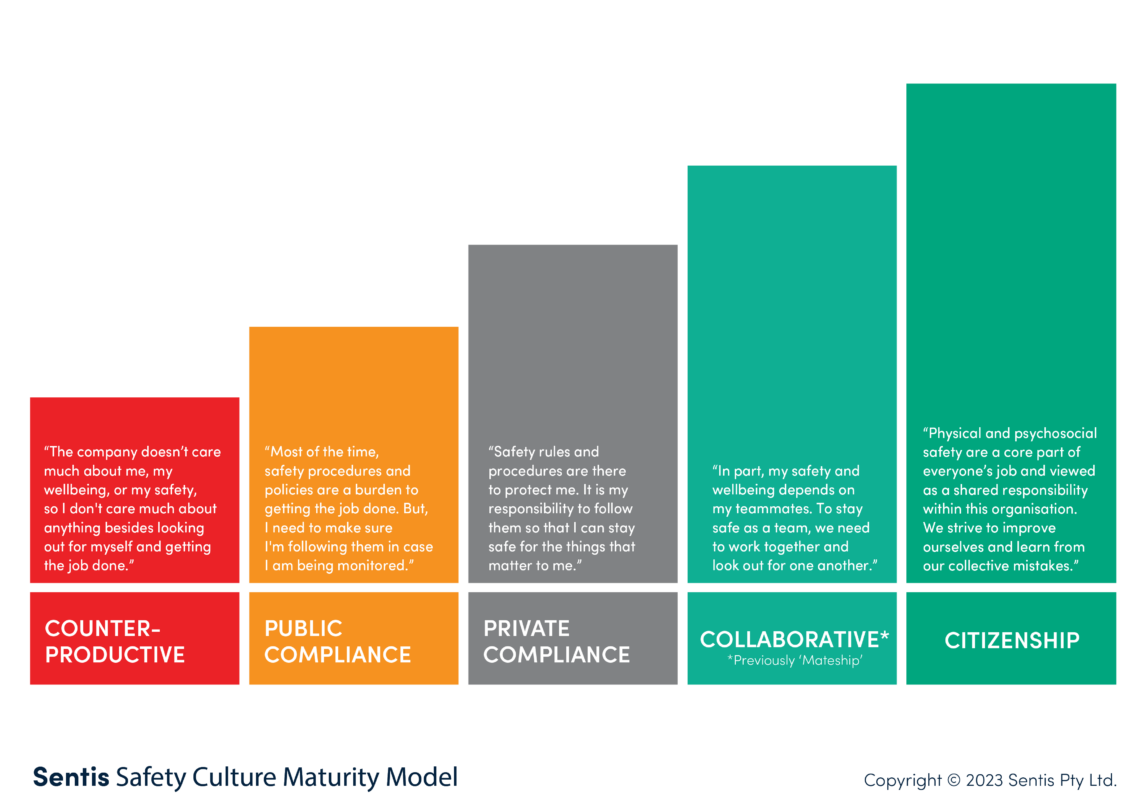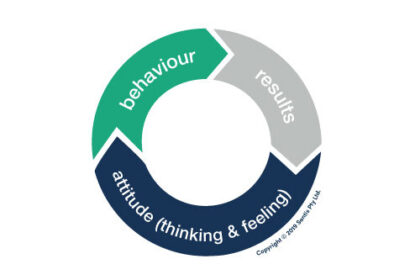Big Changes Start with Small Steps
Your organisation’s safety culture is defined by the shared attitudes, beliefs and values that your people hold. In essence, it’s a measure of ‘the way things are done around here’ when it comes to workplace safety. And while many of us would expect our safety culture to be in support of safety and performance outcomes, the reality is that for the vast majority of work sites, this just isn’t the case.
You see, the results of our recent study spanning 73 organisational sites across eight industries found that a staggering 86% of sites operate from a negative safety culture, with the majority of these sites sitting at the Public Compliance level of safety culture maturity. In Public Compliance cultures, employees only comply with safety procedures when they’re under supervision. The moment the watchful eye of management disappears, so too does their motivation to continue to comply with safety practices and procedures.

At this level of cultural maturity, we also see high levels of underreporting of near-misses and safety hazards—robbing organisations of the opportunity to take a learning approach and prevent major safety incidents from occurring.
In this type of negative safety culture, employees tend to:
- take a ‘tick and flick’ approach to safety, viewing it as a compliance requirement that they only have to adhere to when they’re under supervision
- cover up minor safety incidents because they don’t see the value of reporting them or are afraid of negative repercussions
- cut corners and turn a blind eye to poor safety behaviours, especially during times of increased production pressure.
In essence, they don’t view safety as something they want to engage with. Instead, they think of it as an inconvenient compliance requirement that they have to address in front of management, only to dismiss it when they aren’t being supervised or if production pressure rises.
As a safety leader looking to improve your safety performance, it’s critical to start pushing towards the first benchmark of a positive safety culture—a culture of Private Compliance.
Unlike a Counterproductive or Public Compliance culture, a culture of Private Compliance is one where workers take personal ownership over their safety. They see value in complying and view safety policies and procedures as tools that help them stay safe. As a result, they make the conscious decision to make safe choices—regardless of whether or not they’re under supervision.
Private Compliance safety culture – “I choose to be safe”
Instead of being externally motivated to stay safe because of supervisor expectations or a fear of negative repercussions, workers operating at this level of safety culture maturity are intrinsically motivated to comply with safety procedures because they want to stay safe, and they understand the link between compliance and safety.
Unlike their Public Compliance counterparts who rely on an external driver or a fear of negative repercussions to motivate their compliance, these workers see personal value and benefit from behaving safely. In turn, they share an intrinsic motivation to make safer choices—helping them ensure that they return home safely at the end of each day to the people and things that matter to them most.
But as a safety leader looking to elevate your cultural maturity from Public to Private Compliance, where should you invest your limited resources?
To help you get started, we analysed the data from the sites in our study with Counterproductive and Public Compliance cultures to identify the top five opportunities that you can leverage to begin improving your safety culture.
1. Quality of safety procedures
“If you did everything by the book here, you wouldn’t get anything done.”
It goes without saying that safety procedures are a vital element of an organisation’s safety culture. However, the mere existence of these procedures isn’t enough. Having well documented safety procedures without also ensuring that they’re designed to be efficient is a guaranteed way to ensure minimal compliance.
A reference to the effectiveness, ease and user-friendliness of the procedures you have in place, the quality of your safety procedures has direct implications for how likely your people are to adhere to them—especially when they aren’t under supervision. Left unchecked, you run the risk of accidentally reinforcing a ‘tick and flick’ approach to safety as your people start to perceive them as being driven to serve your company’s needs, instead of their own.
Tip for leaders
A simple strategy to gain a better understanding of the quality and accessibility of safety procedures is to shadow a worker for a day with the goal of understanding how they access procedures, the complexity of them and how easy they are to apply in the field. Once you understand the challenges and strengths, you can seek to influence a review where necessary and/or promote the development of procedures with direct input from frontline workers, helping to ensure that they better serve the people they’re meant to protect.
2. Management safety commitment
“They don’t care about us; they don’t care about safety. They care about production.”
Your people look up to your organisation’s leaders as role-models for safety behaviours. So, despite your best intentions in ensuring a safe workplace, unless you’re also actively showcasing your commitment towards safety and continuously displaying exceptional safety behaviours, your efforts will fall on deaf ears, as this poor role-modelling will set a less than ideal standard for acceptable behaviour on site.
A reference to the quality of your in-field safety visits, as well as your team’s perception of how highly management prioritise employee safety, it’s crucial to ensure that you maintain the same standard of safety behaviours that you expect from your team—especially during times of increased production pressure. That means backing up the things you’re saying about safety with actions that reinforce your commitment to it such as purchasing specialised equipment for your team that allows them to complete a task safely, or advocating within the business for a safety concern to be resolved.
Tip for leaders
To develop stronger perceptions of management’s commitment to safety, start by ensuring your organisation has a clear safety strategy that’s shared with all employees. At the same time, ensure that leaders are on board and accountable for their portion of responsibility.
As you move forward and hit each milestone in your safety strategy, remember to communicate and celebrate the achievements with your team to reinforce your commitment to safety and to nurture the mindset of ‘we’re in this together’.
3. Internal context
“We’ve stopped making suggestions because they don’t listen to us. What’s the point?”
While this element refers to factors internal to the organisation that impact safety performance, such as job security, general morale and perceptions of culture, there’s one element in particular that stands out as a major opportunity—effective change management.
You see, effective change management not only ensures minimal employee resistance when new changes are introduced, but it also ensures that the new changes don’t become a distraction or a point of concern. Otherwise, you run the risk of making your team anxious, withdrawn, hostile and in turn, disengaged with the very procedure or process you are trying to change. While leaders typically consider restructures, mergers or the closure of a site as a major organisational change, workers may feel the same level of tension from minor changes to their routines, rosters or the way that they do their jobs. Left unchecked, ineffective change management can erode trust in leadership and in turn, fuel an ‘us vs them’ mentality that’s typical of negative safety cultures.
Tip for leaders
To leverage this opportunity, start by ensuring that your organisation has established change management procedures in place. Then, whenever you introduce any new changes, ensure that you space them out as much as possible to give your team ample time to adapt without feeling overwhelmed. Throughout the process, also ensure that you maintain open lines of communication with your team from start to finish, to increase transparency and maintain trust.
4. Willingness to report incidents and errors
“It’s fear and intimidation if you report anything.”
Referring to the clarity of incident reporting and how efficiently your workers use reporting channels, this factor is a measure of how likely your workers are to report incidents and errors in an accurate and timely manner.
A lack of willingness to report means that workers are more likely to cover up mistakes or turn a blind eye to unsafe behaviours, robbing your organisation of opportunities to learn and prevent major safety incidents.
The biggest driver behind a reluctance to report? A fear of negative repercussions. Be it a fear of losing their job or gaining a permanent ‘mark’ on their record, this reluctance is further perpetuated in workplaces where incident investigations focus on assigning blame, instead of being leveraged as the key learning opportunities that they are.
Tip for leaders
Start by actively communicating to your team the importance of effective incident reporting and how it benefits their safety. In turn, when incidents do arise, shift your focus towards identifying the lessons to be learned, instead of focusing on finding someone to blame. In doing so, you can help your workers view the decision to submit an incident report as something to be proud of, instead of something they should fear.
5. Employee safety performance
“Safety officers are like police officers.”
Employee safety performance refers to the effectiveness of safety recognition and performance management processes. In particular, it relates to the perceptions of fairness surrounding safety performance management. A key driver behind the issue in sites with poor safety cultures is ineffective or non-existent rewards and recognition for positive safety behaviours.
The bottom-line here is that not all forms of reward are weighted equally. So, while you may currently have incentives in place to reward your workers for their safety performance, if the recognition and rewards provided for production outcomes vastly outweigh those provided for safety, then you’re inadvertently motivating your team to make production their biggest priority. This issue is further perpetuated when those production rewards are earned by cutting corners or making unsafe choices in order to maximise productivity.
Tip for leaders
The first step in addressing this area is to review your existing reward and recognition processes, especially when there are monetary bonuses in place, to evaluate if they may be inadvertently driving unsafe or counterproductive safety behaviours. Then, allocate time to get to know your team on a personal level to gain a better understanding of exactly what they value. Be it the type of reward that they would like to receive, or whether they prefer public or private recognition, ensuring you align the rewards you provide with the factors that they value will help you more effectively motivate them to achieve their safety targets.
Safety is a journey
To bring it all together, your organisation’s safety culture is like a living, breathing entity that needs to be nurtured and supported to thrive. However, at each stage of your journey, there are specific opportunities to drive your safety performance towards the next stage of safety cultural maturity. By focusing your attention on the five key opportunity areas that we’ve discussed, you can start fostering a culture where safety goes from being perceived as an inconvenient compliance requirement to a personally motivated choice.
To learn more about how you can continue to drive a positive safety culture, download a copy of our latest e-book on Driving a Positive Safety Culture.
Together, we can ensure that every worker gets to go home safely at the end of every day to the people and things that matter to them most.




